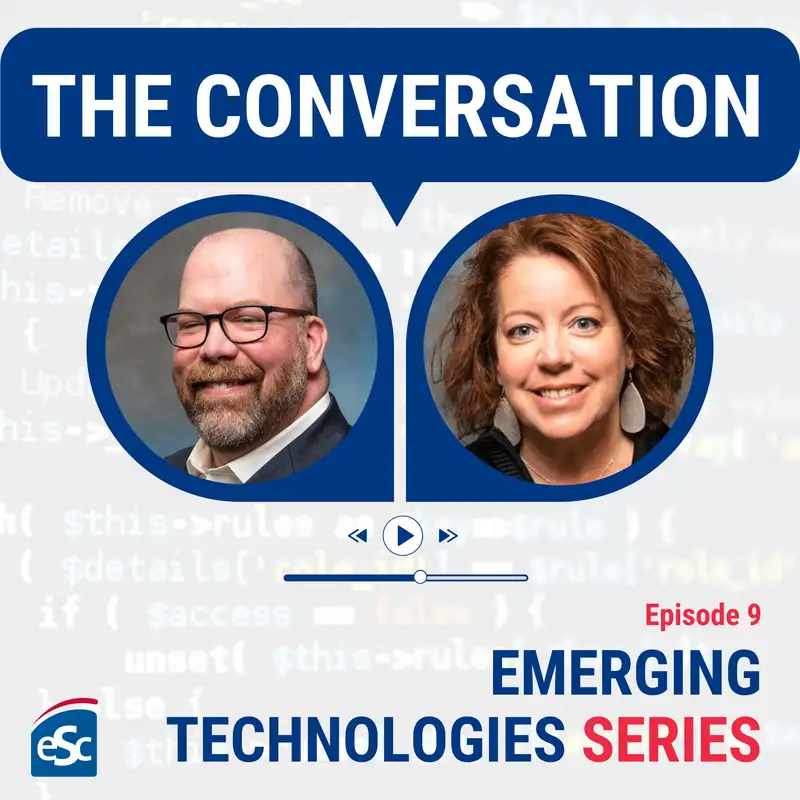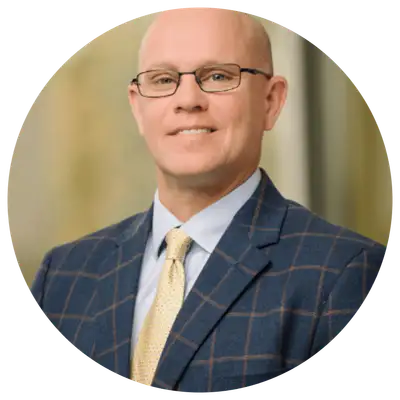
Urban Air Mobility
Speaker 1:
On this special episode of The Conversation, John and Rachel chat with Ted Angel at the National Advanced Air Mobility Center of Excellence. Together, they'll dive into the next transportation revolution, flying cars. Check out the video episode on the ESC of Central Ohio's YouTube channel linked in the description. Let's dive in.
John Hambrick:
Well, welcome back to the conversation, Ohio Voices, igniting ideas and inspiring change. And Rachel, I'm so glad we're together here. I hate to be punny, but I think we're taking this conversation to new heights.
Rachel Daniels:
We just did in the simulator.
John Hambrick:
We did. We did. It was amazing and so grateful to be out here. And we are joined with Ted Angel. Ted, you're the executive director here at the National Advanced Air Mobility Center for Achievement and Leadership and Excellence. So thanks so much for inviting us out to host our first in-person podcast and with here at the Air Mobility Center. So cool. As we get started though, could you share with our listeners what your journey is and how you got to be with us this very beautiful morning here in central Ohio?
Ted Angel:
Yeah. Well, first thank you for having me and giving me the opportunity to be a part of your first video podcast. Super exciting to host you guys at the Center of Excellence here in Springfield, Beckley Airport. My journey started many years ago with the United States Air Force. I spent 27 and a half years in the United States Air Force supporting aircraft pilots, doing safety type gear work that they utilize to survive flying in and out of airplanes. Post-retirement I was really nervous about what life would look like. Spending your whole adult life in the military, what success looked like and I was able to get into economic development locally here through Jobs Ohio, which landed me in this advanced air mobility spectrum that you guys got to witness today and be a part of. And then, eventually, all the work being done across the state, I was fortunate enough to be asked to become the first executive director here at the center and I couldn't be happier.
John Hambrick:
Outstanding. And I'm kind of curious with this air mobility, are you a part of Drive Ohio, Fly Ohio, or are you just a standalone with your Center of Excellence here?
Ted Angel:
That's a great question. We're key partners with all of those entities that you just mentioned so I don't personally work under Drive Ohio or underneath the Ohio Department of Transportation. We are our own organization. We are a nonprofit organization that partners closely with ODOT and Drive Ohio and all of the state entities that are focused on ensuring that Ohio continues to lead in this spectrum.
John Hambrick:
Excellent.
Rachel Daniels:
Well, John and I have learned an awful lot today and for our listening audience, we'd like to expand everyone's vocabulary a little bit so I'm hoping that you'll humor me by talking to me, and John as well, like we're five years old by explaining some important terminology.
Ted Angel:
Sure.
Rachel Daniels:
So we'll do this as sort of like a rapid fire. I'll give you a concept or a term and you explain it in layman's terms so our listening audience can understand.
Ted Angel:
Absolutely.
Rachel Daniels:
So you good with that?
Ted Angel:
Yes. Afternoon soup is what we live by.
Rachel Daniels:
Exactly. That's the same in education.
Ted Angel:
Yes.
Rachel Daniels:
All right, so the first is advanced air mobility.
Ted Angel:
Sure. So advanced air mobility has changed over the course of the years. When we originally defined advanced air mobility, it was encompassing all advanced air mobility, so unmanned aerial system aircraft. So think drones, think this new electric vertical takeoff and landing industry that you hear about, these air taxis, The Jetsons, for those of us that watched that cartoon growing up, it's coming to life finally. Those were all encompassed together. Really, today when we talk about advanced air mobility, it's talking about that electric vertical takeoff and landing. Air taxis, cargo delivery, those type of larger aircraft and advanced [inaudible 00:04:33].
Rachel Daniels:
Expand our understanding of a vertiport.
Ted Angel:
Great question. I will dive as deep as I can, which is very small. That terminology has changed over the course of the years as the FAA started to put time and effort into standing up the engineering brief, the 105 engineering brief that was just released a few months ago. A vertiport is basically like a helicopter pad that's raised and it's built to a new standard to allow these electric aircraft to land with powered lift, which is the new industry term for this industry.
Rachel Daniels:
And I heard you use this term before, so I'm excited to hear your explanation. Explain beyond line of sight.
Ted Angel:
Sure. So we call that BV loss, so beyond visual line of sight. If you're familiar with flying drones, you have to be able to visually see your aircraft while you're flying.
Rachel Daniels:
Okay.
Ted Angel:
The technology you saw today and learned about today we have at the airfield allows us to fly beyond visual line of sight so we can take an autonomous aircraft of any size and fly it without having to see it because of our technology here.
Rachel Daniels:
And you've used this acronym, so I'm excited for our listeners to learn more about this electric vertical takeoff and landing vehicle.
Ted Angel:
Yes. So eVTOL is what you'll hear people say, but that basically is just this new innovative industry where they take off vertically like a helicopter and then as they get to vertical altitude that they're comfortable at, then they start to transition to forward flight and fly like a normal aircraft. And so that's what that terminology means.
Rachel Daniels:
And John and I have some personal firsthand experience understanding that term in action.
Ted Angel:
Absolutely
Rachel Daniels:
Since we had to practice in the simulator today. All right, so on that note, talk to us about powered lift aviation.
Ted Angel:
So this is a great new term that I hope many are starting to learn what it is. This new industry, when it came out, this new electric vertical takeoff and landing industry, people just thought they would adopt helicopter procedures similar and the FAA really started to dive into what these aircraft are and how they are built and decided that, "Hey, we actually have a new style of aircraft and it's going to be called Powered Lift." And so they're using electric motors to create the lift while they then transition to forward flight so...
Rachel Daniels:
All right, final one for now. Unmanned aircraft system.
Ted Angel:
Yeah, so back to the original AAM question. A lot of this started with our drones and most people know that terminology is just drone, but technically it's the unmanned aerial systems and these are all different sizes of drone autonomous aircraft so they can be the small ones you buy at Best Buy or they could be large ones that companies produce that are going to do package delivery to your house in the near future.
Rachel Daniels:
You mentioned the connection back to The Jetsons and growing up. Not to age myself, but growing up in a time where I was quite a fan of The Jetsons and never thought that Rosy would come true. We know the role robots play and now to see this notion of flying cars, it's kind of mind-boggling, but so important for us to keep up with the trends so I appreciate you helping us unpack those terms a little bit.
Ted Angel:
Absolutely.
John Hambrick:
Ted, I'm going to ask you here in just a minute about the significance of air mobility in Ohio historically. But you mentioned for the UAS, unmanned aircraft systems, you spoke of drone size, right? What we as most consumers would buy from a Best Buy or something and we've seen under the Christmas tree, but when we talked about this vertical takeoff and landing vehicle where we're using an air taxi, can you give our listeners... Kind of paint them a picture of the size of this vehicle.
Ted Angel:
Sure. So it's very unique because all the companies are building at different sizes, right? Beta technology who has a presence here locally at our airfield, their aircraft is basically a 50 by 50 wingspan in length, where others are more compared to a small Cessna or a small Sierra type aircraft that you would see in general aviation flying. And so they're a lot larger than I think people expect when they see them in person, but they're a lot smaller than your standard airliners or other aircraft.
John Hambrick:
So imagine maybe a Ford F-150.
Ted Angel:
Yes.
John Hambrick:
That kind of size, that length, but put propellers and some joysticks and take that bad boy off and get some air flight, right? Is that about right for what I was saying?
Ted Angel:
Yeah, I mean that's a good cut. They're probably slightly bigger than an F-150, maybe if some of those larger big trucks that people buy for moving farm equipment and things like that. Decent halfs and some of those type of aircraft or automobiles would probably be a little more to scale.
John Hambrick:
But it's not huge.
Ted Angel:
No.
John Hambrick:
Right?
Ted Angel:
No.
John Hambrick:
It's not your... You mentioned like a Cessna, but it's about that size but manageable that we're going to be able to see this vehicle in the air in our cities and the first city I think that Joby is going to be piloting this, pardon the pun, but Dubai, does that sound all right?
Ted Angel:
Yeah. And I don't want to speak for Joby and their plan to unleash their aircraft, but obviously they're very interested in Dubai and the UAE based off of the innovation and the regulations and control of regulations to be able to fly those aircraft a little bit sooner than maybe we will be able to here locally in the U.S.
John Hambrick:
I love it. All right, I'm going to bring us back to our Ohio roots.
Ted Angel:
Sure. Sure.
John Hambrick:
So air mobility in the state of Ohio here in the Dayton Springfield area. Why did the Center for Excellence choose this particular area?
Ted Angel:
Sure. That's a phenomenal question and one, it's easy to answer because we're a short 12 miles from where the Wright brothers flew the first powered aircraft, right? So that's an exciting time. That's the initial stage, first phase of flight. We're really close to Wright-Patterson Air Force base and the Air Force Research Lab, which arguably with help from NASA Glenn played a huge part in the second revolution of flight, the jet engine world, that changed our lives and our ability to travel. And so it just made sense to partner again with our Wright-Patterson, our Air Force, our Air Force research lab team to have that third revolution of flight, electric flight also happen right here locally in the area.
John Hambrick:
So exciting. I think about really our students at an elementary school right now, our students that are in the middle grades, how this is a viable occupation for them upon graduation of high school and maybe an additional degree, but just it's Jetsons coming to reality.
Rachel Daniels:
[inaudible 00:12:12].
John Hambrick:
It's just so cool.
Rachel Daniels:
Well, to your point, John, I'm curious, Ted, what your vision for advanced air mobility is when you think about unmanned aircraft systems. So talk to us about that. What do you see in the future?
Ted Angel:
Sure. Well, selfishly here at the NAAMC, I want to continue to attract, retain, and expand our capabilities and I want to attract more companies like the Joby's and the Betas and the Archers and any others that are out there in this line of business. Show them that Ohio is a place they want to be because of our strength in manufacturing, our supply chain, and our ability to adapt and be innovative with them as they're expanding and growing their own industry. Most of these are all startup companies, right, and so bringing them to fruition to be a part of that is absolutely exciting to me to see something that's a prototype then become certified and then sold and see it flying around our communities every day is just exciting and that's why I want to be a part of it and where I see Ohio playing a critical role as this industry unfolds.
Rachel Daniels:
Well, as we begin to wrap up our conversation, it behooves me to ask a question that connects to a passion of mine and that's disciplinary literacy. And in that perspective, in literacy work, we think about how can you best apprentice students into the kinds of thinking within a discipline that you would find in the field while giving students time in the classroom to really explore that work in a classroom setting. And so I'm curious to hear from you what you see around the future of aviation jobs and what needs to happen in schools so that educators can better prepare students to fill these roles that we have learned about today. Are really going to be at the cutting edge and sort of frontline of new jobs that are coming down the pike for those very elementary students who probably right now can't envision what that job possibility might be one day. So talk to us about what schools, what educators specifically could do to situate students to be in a position to be thinking about career in this aviation path.
Ted Angel:
Sure. I think the first thing I always try to talk to educators about is to not be afraid to expose yourself to this new technology. So being open-minded that this is happening, it's not going to happen, it is happening. These aircraft are here, they're flying, they're testing, they're getting certified, and we're going to see them. And so find ways educationally that you can adapt how you are teaching and exposing your students to something new, right? I know we have to stick to curriculum and we have to do certain things in the education world, but I always try to encourage folks to not be afraid to think outside the box to say, how could I adjust my curriculum to still accomplish what my goal is, but maybe add a notch or two to it so that people have exposure at an earlier age.
I think I told the group earlier, right? I love to talk to fourth graders because my goal is to really get them motivated about aviation that early. So as they go through their young adult life, I'll call it, and they get into high school and graduating, they see it as a possibility. I think about when I was a kid, that's not where my mind was. I was just focused on baseball and not getting in trouble, right?
John Hambrick:
Relatable.
Rachel Daniels:
Good goals.
Ted Angel:
At home... But our youth today are exposed to so much innovation and we have to stay on top of understanding what it is educating ourselves as educators, and then how do we transition that into maybe pushing the envelope to change a curriculum or adopt a new curriculum that we normally wouldn't do because it's important to the youth to have exposure and see, "Man, I could be the next power lift electric mechanic. I could be the next power lift airplane pilot." Those are things that not all kids are thinking about. And so the more and more we expose them like we did today for you guys to this technology and this capability, I think it just aligns with then smart people like you guys to tackle that education side and really start to revamp and expose people to those capabilities.
Rachel Daniels:
To your point, I think that when John and I are participating in this podcast and learning about different organizations or entities that have an impact on our educational frameworks, we both often think, first of all, did we choose the right career path? What did we miss out on? [inaudible 00:17:12].
John Hambrick:
Because this is cool.
Rachel Daniels:
Yeah. What have we missed out on? But also thinking about in what ways can we best share this information and get it out and even getting students to understand what Joby and the other entities are, what they offer, and the ways that this work is really going to impact career paths down the road is so important.
Ted Angel:
Yeah, absolutely. And we're continuing to grow that knowledge. You mentioned Drive Ohio earlier in our conversation, and if you go out onto ODOT's website and you go to Drive Ohio, they have a really unique toolkit that's designed for multiple education topics, but advanced air mobility is one of them.
John Hambrick:
Absolutely.
Ted Angel:
And so you can go in and click on that link and you could host a fourth grader vertiport challenge where they're using cardboard to learn how to build what a vertiport would look like, and what should be a part of it, and what's missing. Does it have electric charging? Does it have all the things that you need to do those type of things? And so there's a lot of resources within the state, not only here at the NAAMC where we partner with all the colleges and universities within the state to continue to educate and look for ways to produce the future workforce for this industry, but at the lower levels of education, those toolkits with ODOT and things like that are right at the fingertips for people to go ahead and at least start to expose a little bit and not have to create it all themselves, right? And then you do it once and then you use your creative minds to then grow it and build it and turn it into what you need it to.
Rachel Daniels:
Well, Ted, John and I are so thankful for the time you made for us today. The tour of the facility, learning some of the ins and outs, that was new learning. I know I'll speak for myself in large part for me. Obviously, visiting a vertiport was incredible to see and think about what that might look like in the future and then our experience at Joby and being able to fly and earn a badge-
Ted Angel:
Nice.
Rachel Daniels:
... for flying the simulator. It was I'll say once in a lifetime at this point.
John Hambrick:
I would agree with that. I would absolutely agree.
Rachel Daniels:
I waws recently in New York City and recently saw the Statue of Liberty and never imagined that I would simulate my own flight around her so that was pretty incredible. So we are so thankful for the time that you shared with us and the learning that we were able to engage in. For John, this is Rachel. Keep curious and stick with The Conversation.
Episode Video
Creators and Guests


